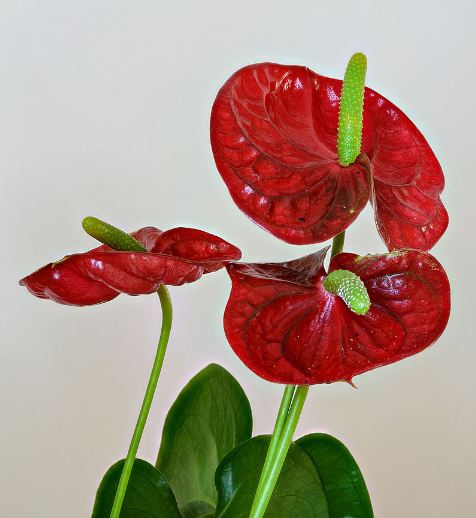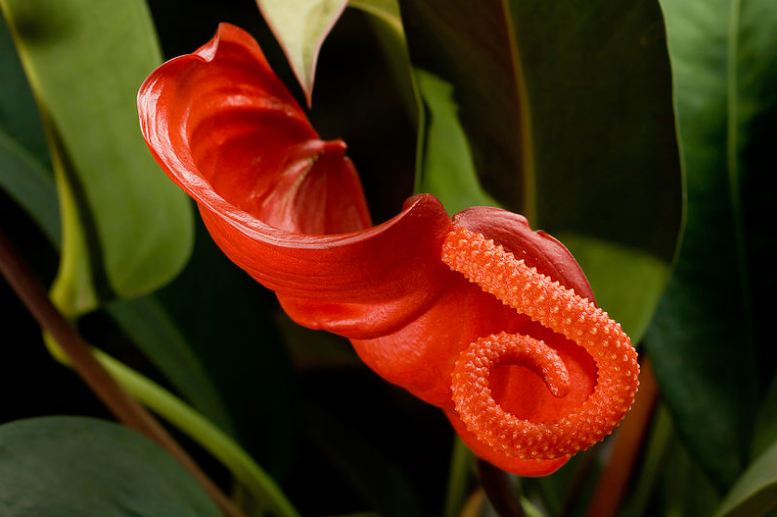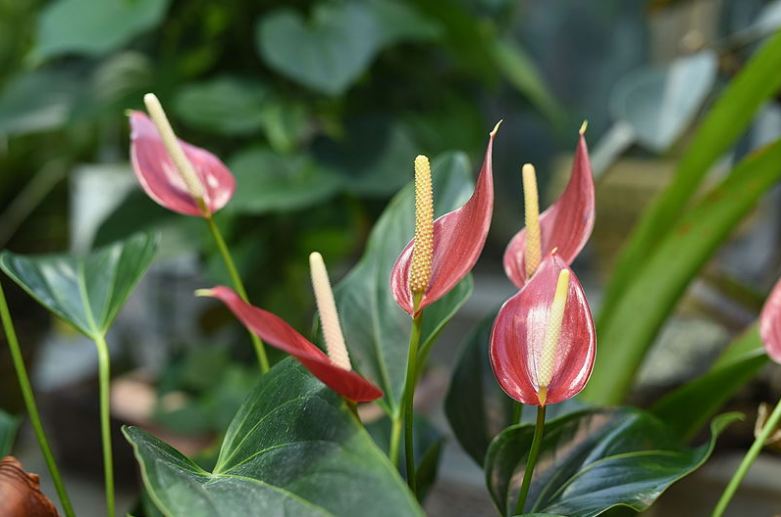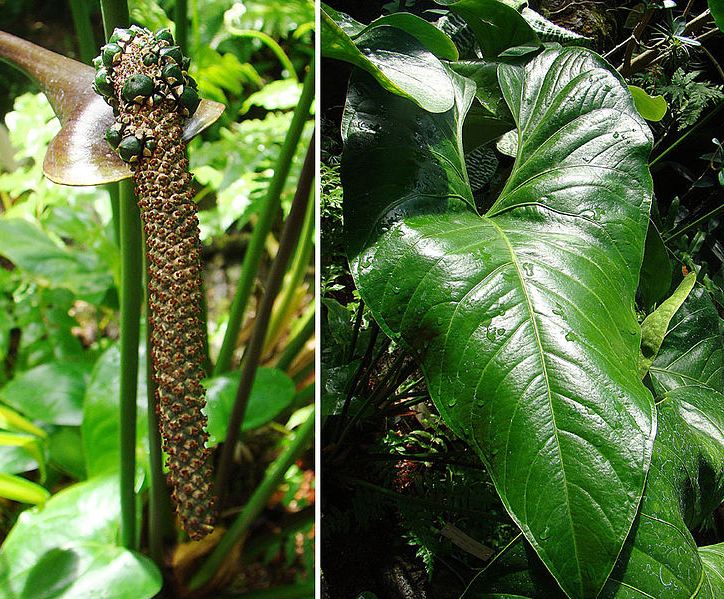Anthurium is a houseplant that is usually kept in houses for decoration purposes. This plant’s heart-shaped leaves are usually referred to as “flowers,” these waxy leaves look like flowers because of their pretty colors like red, pink, and purple. These leaves are called spathes, and they flare from the fleshy spike base; this is where the tiny flowers (the actual flowers of Anthurium) grow.
Anthuriums are epiphytes, which means that these plants grow in warm regions where they grow on the surfaces of other plants or in the rich organic humus. It must be noted that Anthuriums If ingested, are poisonous and must be kept away from kids and pets.
Popular Types of Anthurium
1. Anthurium Scherzerianum
This species of Anthurium has large, lance-shaped leaves that are glossy in texture. Its red flowers are curled downwards and are made of a flat waxy bract, and the spadix is pinkish. Another name for this flower is Pig’s tail Anthurium because of the curled and twisted spadix.
2. The Flamingo Flower/Lilies (Anthuriumandreanum)
This species has flowers that are red in color and waxy in texture. The spathes are glossy and heart-shaped. The spadix of a flamingo flower is straight and not curled and is usually yellow or white. The leaves of this species are dark green and heart-shaped, creating bushy foliage.
Flamingo lilies look very much like the Anthuriumscherzerianum, and the difference between these two species is that the flamingo lily’s spadix is not twisted like scherzerianum’s.
3. The Velvet Cardboard Anthurium(Anthuriumclarinervium)
Mostly prized for its beautiful green and white leaves,Anthuriumclarinveriumis a tropical species. The thick white veins in its leaves provide stunning markings on the leave’s surface. The flowers and spathes of this plant grow on the end of its long stem.
4. The Black Anthurium(Anthuriumwatermaliense)
As the plant’s name suggests, the bracts of this plant look like they are black, but in reality, it’s the extremely dark purple color of the bracts that makes them look black. The leaves of this plant are dark green with a glossy texture, and they look like lanceolate. The foliage of this plant grows in the form of a rosette. The shape of its leaves is. These plants don’t have any prominent markings on them.
5. Bicolor Midori Anthurium
The Bicolor Midori Anthurium, mostly found in the tropical regions of South America, has flowers having a unique appearance. These plants are double-colored; one of these colors makes a border around the heart-shaped leaves while the other one is darker and brighter in color, and it spreads all over the flower.
The color combinations are usually pink and green, white and green, or yellow and green. They are long-lasting by nature and can easily be kept inside a vase for more than a month without fading or wilting.
6. Shaded Anthurium
A scarce but beautiful variety of Anthurium is the shaded Anthurium. This plant’s spandex is yellow and white-colored, while the flowers are attractive because of the shaded pink and red color, which spreads all over the flower. The flower of this plant has a diameter of no more than 14 to 16 centimeters.
How to Take Care of Anthurium Plants?
Being houseplants, Anthuriums are easy to keep and only require a little care. If these plants are taken care of perfectly, they can bloom more than usual and increase the beauty of their surroundings just by being there. Here are some things you need to look out for if you have an Anthurium plant in your house:
1. Light
The indirect light of any level is tolerable for an Anthurium plant, but low light can cause slow growth and fewer flower production. Anthuriums cannot tolerate direct light/sunlight because direct light harms and burns their leaves. Therefore, it is best to keep them in indirect bright light for healthy growth.
2. Water
The roots of Anthurium are most likely to rot when they are overwatered. Hence, you should never overwater your Anthurium plant; always water it thoroughly only when the first inch of its soil dries and stop watering when the water starts flowing from the drainage holes. The water need of Anthurium is directly proportional to the amount of light and warmth it is getting. The more light and warmth it gets, the more water it needs. Therefore, it is advised to keep a check of the dryness of the soil.
These plants do not need much water during winters because, in this season, Anthuriums do not grow actively.
3. Temperature
Anthuriums are not very sensitive to temperature as they are extremely adaptable and can bloom in any typical household temperature. But, extreme temperatures can be harmful to these plants temperature that drops below 50°F. Temperature below 50°F can cause the growth of your Anthurium to stop, and extremely high temperatures will cause its wilting.
4. Fertilizers
Too many fertilizers are not required for an Anthurium plant. They only need to be fertilized once every three or four months. A fertilizer with a higher phosphorous number works best for Anthuriums in their growing seasons, such as spring or summer.
5. Humidity
Most Anthuriums thrive in humidity, but this growth differs in flowering varieties because they can tolerate more dryness. If the humidity level drops below 50%, it is advised to use a humidifier so the level can increase up to 60%. This will help the plant grow and flourish.
Tips for Better Anthurium Growth
- Fertilizers with high phosphorous should be used for the better blooming of flowers in the flowering variety of Anthurium.
- The type of soil that works best for Anthuriums can drain the extra water and hold enough of it into them to provide moisture. This is because excessive water can cause rotting of the roots.
- Change the pot of the plant as it grows bigger. Anthurium roots, when crowded, can cause the growth of the plant to lessen or even stop.
- If you see some roots growing out from the stem, there is no need to worry. These roots are called the aerial roots, which are there to get benefitted from the occasional misting. You can cut these aerial roots without damaging the plant if you do not like their look.
- If you want to remove the faded flowers from the plant, all you need to do is cut them from the base of the flower stem. Be sure that you cut them from the part which is closest to the base of the plant.
- There is no special pruning required for these plants, but if you still feel the need for it, only prune the decaying or already-dead foliage.
- The best method for the propagation of an Anthurium plant is by dividing its roots. First, remove the plant from the pot and then divide its roots into two or three sections. Make sure that every section has at least two stems in it.





